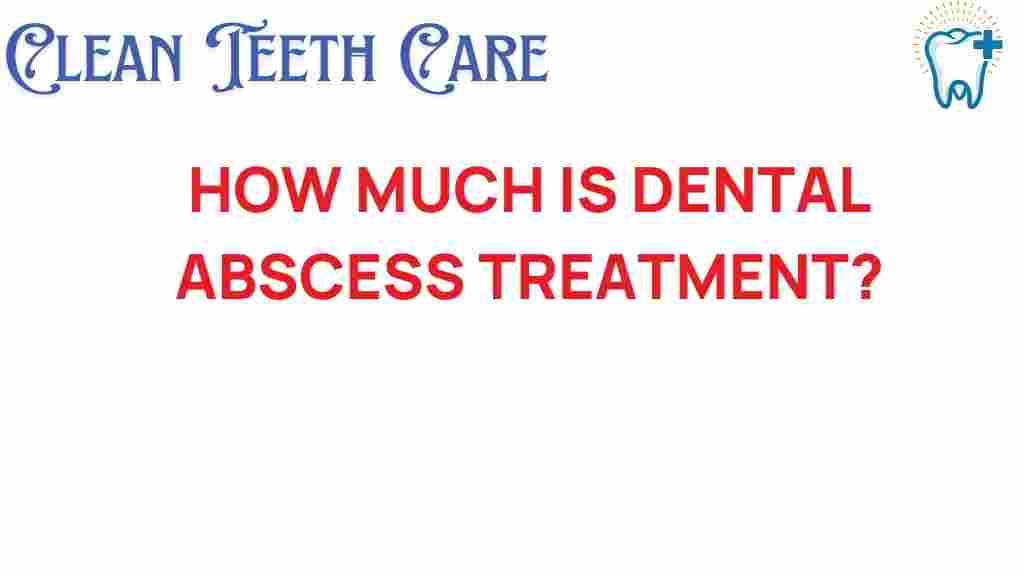Uncovering the Costs: What to Expect from Dental Abscess Treatment
A dental abscess is a painful condition that arises from an infection at the root of a tooth or in the gums. It can lead to severe discomfort and complications if not treated promptly. Understanding the treatment costs associated with a dental abscess is crucial for anyone facing this issue. In this article, we will explore the costs involved, the various dental procedures you may encounter, and how to manage pain effectively during treatment, all while emphasizing the importance of prevention and maintaining good oral health.
Understanding Dental Abscesses
A dental abscess is essentially a pocket of pus caused by a bacterial infection. This infection can occur due to a variety of factors, including:
- Poor dental hygiene
- Untreated cavities
- Gum disease
- Trauma to the tooth
If you suspect you have a dental abscess, it is important to seek treatment as soon as possible to avoid more severe complications and to manage the pain effectively.
The Costs of Dental Abscess Treatment
When it comes to dental abscess treatment, the costs can vary widely based on several factors, including:
- The severity of the abscess
- The type of treatment required
- Your location
- Your dentist’s fees
- Insurance coverage
On average, the costs for treating a dental abscess can range from $300 to $2,000. Here’s a breakdown of potential treatment costs:
Initial Consultation
Most dentists will charge for an initial consultation, which typically costs between $50 and $150. This fee may also include X-rays to assess the condition of the tooth.
Drainage Procedure
If the abscess needs to be drained, this procedure can cost between $200 and $800. The dentist will make an incision to drain the pus and relieve pressure.
Root Canal Treatment
If the infection has reached the root of the tooth, a root canal may be necessary. This procedure can cost anywhere from $700 to $1,500, depending on the complexity of the case and the tooth involved.
Tooth Extraction
If the tooth is severely infected and cannot be saved, extraction may be the only option. Tooth extraction costs generally range from $75 to $300 for a simple extraction and $300 to $800 for a surgical extraction.
Follow-Up Treatments
After the initial treatment, follow-up visits may be required, which can add an additional cost of $50 to $200 per visit.
Insurance Coverage for Dental Abscess Treatments
Insurance coverage can significantly affect the overall cost of dental abscess treatment. Most dental insurance plans cover a portion of the costs associated with abscess treatment, but the extent of coverage can vary:
- Preventive Care: Regular check-ups and cleanings are usually covered.
- Basic Procedures: Treatments like fillings and extractions are often partially covered.
- Major Procedures: Root canals and surgical procedures may have higher out-of-pocket costs.
Always check with your insurance provider to understand your coverage limits and any co-pays you may be responsible for before proceeding with treatment.
Pain Management During Treatment
Managing pain during a dental abscess treatment is crucial for a comfortable experience. Here are some common pain management options:
- Local Anesthesia: Your dentist will likely use local anesthesia to numb the affected area during procedures.
- Over-the-Counter Pain Relievers: Ibuprofen or acetaminophen can help manage pain post-treatment.
- Prescription Medications: In cases of severe pain, your dentist may prescribe stronger medications.
It is important to follow your dentist’s instructions regarding pain management and to communicate any discomfort you experience during or after treatment.
Preventing Dental Abscesses
Preventing a dental abscess is always better than treating one. Here are some effective prevention strategies:
- Maintain Good Oral Hygiene: Brush at least twice a day and floss daily.
- Regular Dental Check-Ups: Visit your dentist every six months for cleanings and check-ups.
- Healthy Diet: Limit sugary foods and drinks that can contribute to cavities.
- Stop Smoking: Smoking can increase the risk of gum disease and tooth decay.
By adopting these practices, you can significantly reduce your risk of developing a dental abscess.
What to Expect During Dental Abscess Procedures
Understanding what to expect during a dental abscess treatment can alleviate anxiety. Here’s a step-by-step overview:
Step 1: Diagnosis
Your dentist will examine your mouth, take X-rays, and discuss your symptoms to confirm the presence of an abscess.
Step 2: Treatment Planning
Based on the diagnosis, your dentist will recommend a treatment plan tailored to your needs.
Step 3: Administration of Anesthesia
Before any procedure, local anesthesia will be administered to numb the area and prevent pain.
Step 4: Procedure
The dentist will either drain the abscess, perform a root canal, or extract the tooth, depending on the severity of the infection.
Step 5: Post-Operative Care
Your dentist will provide instructions for care after the procedure, including pain management and oral hygiene tips.
Troubleshooting Tips for Dental Abscess Care
Here are some troubleshooting tips to help you manage any issues that may arise during recovery:
- Increased Pain: If pain worsens after treatment, contact your dentist immediately.
- Swelling: Mild swelling is normal, but if it increases, consult your dentist.
- Fever: A fever may indicate a persistent infection; seek medical advice if this occurs.
- Medication Side Effects: Report any adverse reactions to prescribed medications to your dentist.
Conclusion
Understanding the costs associated with dental abscess treatment is essential for effective dental care and oral health. From initial consultations to follow-up visits, knowing what to expect can help you make informed decisions. By prioritizing prevention and maintaining good dental hygiene, you can reduce your risk of developing an abscess in the first place. If you’re experiencing symptoms of a dental abscess, don’t hesitate to reach out to a dental professional for advice and treatment options.
For more information on maintaining oral health, check out this helpful resource. Remember, proactive dental care today can save you from costly and painful procedures tomorrow!
This article is in the category Treatments and created by CleanTeethCare Team
